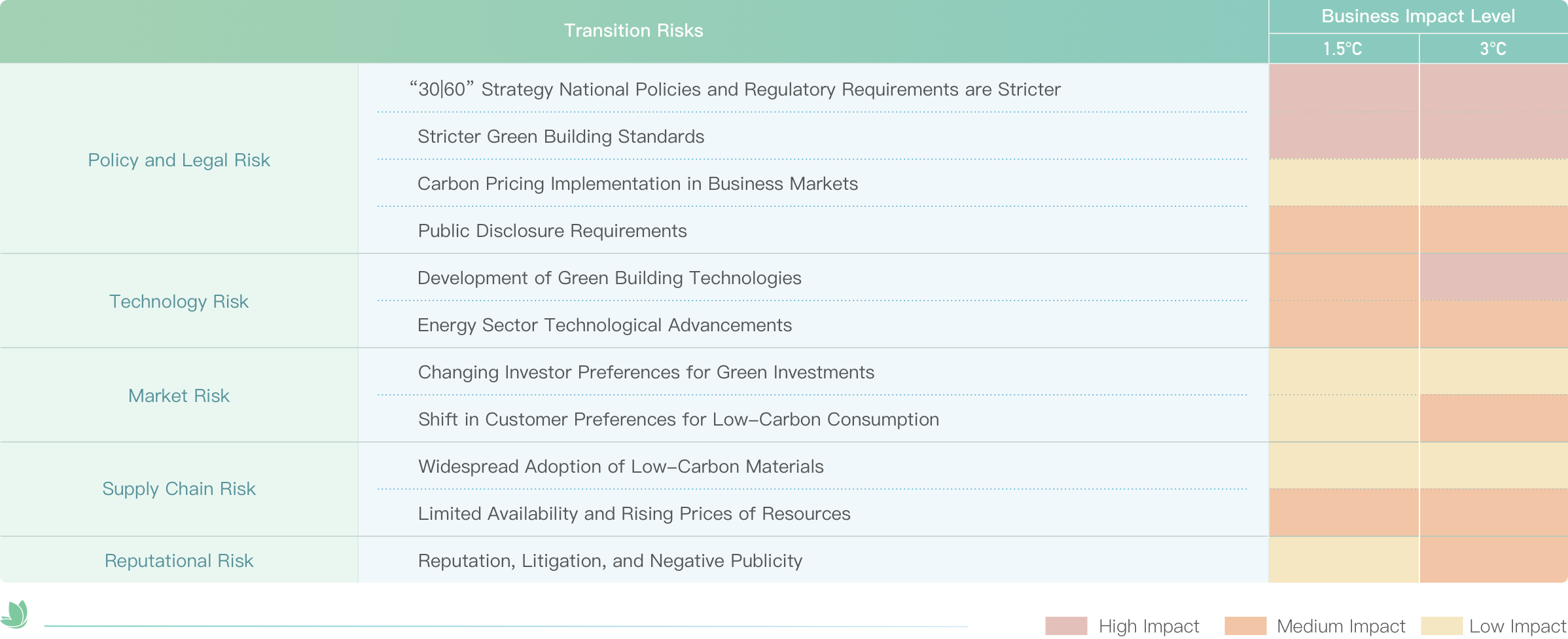- Annual Average Temperature Increase
- Sea Level Rise
- Extreme Heat
- Typhoons
- River Flooding
- Rainfall Flooding
- Extreme Cold
- Extreme Snowfall
Climate Change Response
In order to enhance risk management and seize development opportunities, Yuexiu Property has earnestly formulated and disclosed its climate risk response strategies, doubled its efforts to manage and respond to climate change risks, and promptly grasped the opportunities brought by climate change.
Yuexiu Property has incorporated climate change management into the responsibilities of the sustainability governance structure, in line with the International Financial Reporting Sustainability Disclosure Guidelines No. 2 (IFRS S2)--Climate-related Disclosures, and pushed forward climate change-related work through coordination at all levels. Meanwhile, the Climate Change Response Working Group has been established, and the corresponding countermeasures have been formulated based on the identification and analysis of climate-related risks and opportunities.

Yuexiu Property has utilised a climate risk model to analyse the influences of climate risks of the 27 cities where it operates under the scenarios of temperature rises of 1.5°C and 3°C in accordance with international standards and the requirements of the Hong Kong Stock Exchange, and improved climate factors and incorporated them into its strategies and operations.
Chronic Physical Risks
-
Annual Average Temperature Increase
The average annual temperature has risen compared to historical levels, primarily due to increased greenhouse gas emissions from human activities.
Annual Average Temperature IncreaseSignificance of physical risks: 01
-
Sea Level Rise
Global sea levels are on a long-term rising trend, leading to the flooding of low-lying and coastal areas.
Sea Level RiseSignificance of physical risks: 02
Acute Physical Risks
-
Extreme Heat
Temperatures were significantly higher than normal, with serious implications for employee health and safety and resource consumption.
Extreme HeatSignificance of physical risks: 03
-
Rainfall Flooding
Excessive rainfall causing floods, which can damage infrastructure and threaten lives.
Rainfall FloodingSignificance of physical risks: 06
-
River Flooding
Overflowing rivers leading to widespread flooding, damaging communities and property.
River FloodingSignificance of physical risks: 05
-
Typhoons
Tropical storms bringing strong winds and heavy rainfall, causing structural damage and environmental safety hazards.
TyphoonsSignificance of physical risks: 04
-
Extreme Cold
Extreme cold temperatures leading to increased resource consumption and affecting project delivery.
Extreme ColdSignificance of physical risks: 07
-
Extreme Snowfall
Heavy snowfall impacting project progress and completion, and causing damage to buildings.
Extreme SnowfallSignificance of physical risks: 08
climate risk model

Committee
Committee
Committee
Committee
Leadership Group
Executive Group
Response Working Group
-
Board of Directors
Board of Directors
Responsible for the leadership and decision-making on strategic directions related to tackling climate change;
Regularly hear and review the climate-related work reported by the sustainability Committee;
Empowering the Sustainability Committee to provide oversight of climate-related work;
-
Sustainability Committee
Sustainability Committee
Develop and review climate-related strategies;
Develop key targets for climate-related risks and regularly review performance and report to the Board;
Supervise the progress of climate management efforts;
-
Sustainability Leadership Group
Sustainability Leadership Group
Coordinate and arrange climate-related risk mechanism and work mechanism;
Take charge of overall implementation of climate-related strategies and targets;
Assessing specific climate-related risks and opportunities;
Supervise the implementation of climate-related risk and opportunity management;
Review climate-related risk management performance and report to the Sustainability Committee;
-
Sustainability Executive Group
Sustainability Executive Group
Coordinate the implementation of specific climate-related risk and opportunity management tasks across departments and assist in resolving implementation issues;
Timely feedback to superiors on climate-related work;
-
Climate Change Response Working Group
Climate Change Response Working Group
Identify specific climate-related risks and opportunities, and implement stewardship practices;
Information collection and reporting, report the latest information on tackling climate change;
Responsible for disclosing climate-related information in sustainability reports and confirming the accuracy of climate information and data;
Timely feedback on the achievement of climate risk-related performance indicators;
